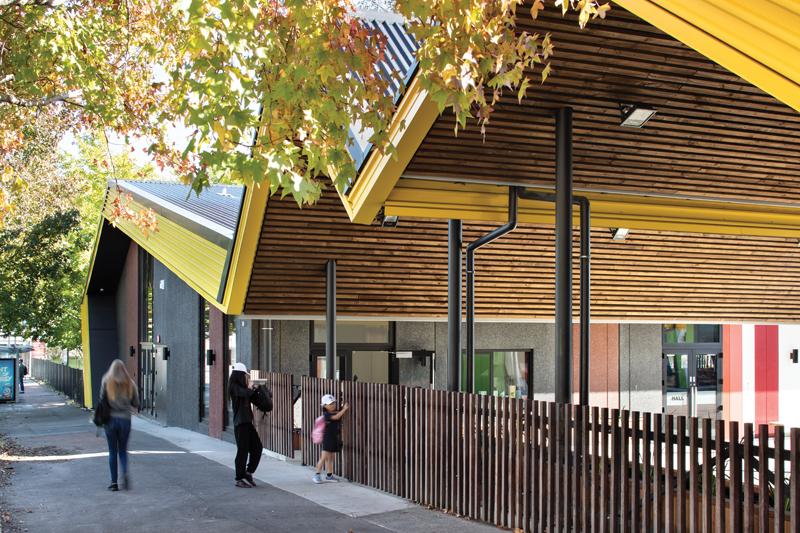Freemans Bay School. Modern Learning.

When Freeman’s Bay school in Auckland needed redevelopment done, RTA Studio stepped in to design a building that proposes a solution type of architecture that inspires learning and promotes the fulfilment of potential in the local rangatahi (younger generation / youth).
The redevelopment programme saw the school almost entirely rebuilt on the existing site. Classrooms have been shifted around but the school stayed operational during the construction period.
The main drivers behind the need for redevelopment were aged buildings, weathertightness, and asbestos issues. Most of the classrooms were built in the 60’s and 70’s. The redevelopment included four new buildings, a hall, administration block, library and a two-storey learning block. The only building left unchanged was a classroom block built in 2010.
“Freeman’s Bay School is designed to create a fresh new centre of modern learning which looks to the future while encouraging close ties with the community, history and landscape,” says Moshin RTA Studio.
Principal Sandra Jenkins was instrumental in the re-development of the school which has pioneered the government’s ‘innovative spaces’ learning strategy. She says the learning-centred approach in an innovative environment aims to inspire and support students develop positive attitudes towards learning.
Sandra was the recipient of a travel fellowship in 2014 to study school design overseas. What
influenced her most was visiting schools in Scandinavia, Denmark and the UK where the role of design links students with what they might expect to find in the ‘real world’ of an activity-based work environment- a future-focussed approach with inspirational open learning spaces.
This vision has been replicated at Freemans Bay School, RTA Studio embracing the concept of unique learning spaces with both vertical and horizontal connections of the physical space within the school. The double height design includes an internal stairwell, in an area that can become an auditorium where up to 90 students can gather for a presentation or where students can share a sit-down learning space. Children love elevation but also enclosed spaces such as the space beneath the stairwell where a cave-like space is created.
An important feature of the design is that it encourages movement, says Sandra Jenkins. “We don’t want our students to be static so the opportunity for activity has been able to be pushed by the design element so there are lots of ways students can move around. Movement keeps the brain working and ensures students are active and alert. I have more ideas to build on this concept of enabling movement within the spaces we have.
“RTA Studio were great to work with and the learning spaces are really innovative: the collaborative effort of the Board of Trustees, Ministry of Education property managers, school leaders and experts in learning environments has resulted in us achieving something that is different and the high level of student engagement in learning is evidence of what this new strategy can deliver”.
The removal of existing 1960s school buildings and carpark facilities made way for four new buildings that open onto a new central courtyard, encouraging social interaction, and outdoor learning.
A visually striking canopy connects the new multi-purpose hall and administration building to the entrance in Wellington Street. The canopy also functions as an inviting outdoor teaching space and covered play area. The ridgeline reflects both traditional Maori designs and typical roof forms of the colonial era flats and townhouses in the surrounding area.
Steel & Tube were heavily involved in coordinating the metal cladding elements.
Moshin from RTA Studio says: “The vibrant and rich colours on the buildings represent the diverse cultural community, and the children’s different ethnic backgrounds.”
The new learning hub is situated behind the admin building. This building provides advanced ‘innovative learning environments’ (80-90 pupils per ‘classroom’ in open-plan spaces), offering a variety of new building materials and technologies. The exterior cladding uses an innovative curtain wall system which spans past the floor slab. The cladding is made of coloured glass panels, backed with insulation against a pinboard interior, all housed in the same frame. Flexible teaching spaces allow for a variety of pedagogical practice, as well as a multitude of subjects and disciplines, for use by the school and the community alike.
The new whanau ata / library building is situated West behind the hall and the existing 2010 learning building is in the North-east.
The design to into account both the embodied carbon and operational carbon footprint. While not specifically targeting any sustainable rating systems, various sustainable principals and design benchmarks have been applied to this project. Construction methods were encouraged to minimise demolition and construction waste through efficient use and ordering of materials.
Durable low maintenance cladding materials externally, and large Autex acoustic panel internal linings achieved the functional requirements of the spaces, while minimising the ongoing maintenance requirements of the external and internal spaces.
All buildings achieve a high level of thermal and acoustic comfort and performance and a high level of natural light through double glazed windows, above code insulation values. A strong preference for south facing windows with large overhangs minimise solar heat gain. Automatic operable windows offer adequate cross-ventilation of all learning spaces while being linked to weather station control of internal temperature and air quality.
The extensive roof areas provide an ample supply of rainwater harvesting for site irrigation, and Solar power generation via photovoltaics assist with the school’s electricity demands. The alternative power generation has also been incorporated into educational activities with tracking display boards.
Awards
- 2019 Auckland Architecture Award
- 2018 Learning Environments Australasia awards, Commendation
- 2018 Resene Total Colour Awards Winner - Colour Master Nightingale Award
- 2018 Resene Total Colour Awards Winner - Education-Primary
- 2018 Architizer A+ Awards, Finalist - Architecture + Community
